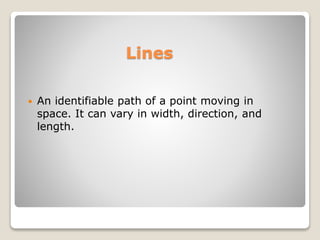What is art ?
- 1. What is Art? An introduction to the concept of art
- 2. Objectives of the Activity Determine a definition of art Decide what is art and what is not art Define terms related to the viewing of art Examine two images critically
- 3. In small groups answer the following Questions What is art? What are different types of art? How does art influence society? Why is art important? What sort of messages do art have?
- 4. Image #1 Is this art? Why or why not? What elements does it have or not have?
- 5. Image #2 Is this art? Why or why not? What elements does it have or not have?
- 6. Image #3 Is this art? Why or why not? What elements does it have or not have?
- 7. Image #4 Is this art? Why or why not? What elements does it have or not have?
- 8. Image #5 Is this art? Why or why not? What elements does it have or not have?
- 9. Image #6 Is this art? Why or why not? What elements does it have or not have?
- 10. Elements of Art Perspective Light Color Form Motion Proportion Symbols Lines
- 11. Perspective Perspective is the way in which artists create an illusion of depth on a flat surface. For hundreds of years painters have tried to represent accurately a scene that exists in three dimensions on a two-dimensional canvas. One of the ways to create this illusion is to make the objects that are far away smaller than those that are closer to the viewer.
- 12. Light Just as stage designers use lighting to spotlight a performer, painters will often highlight important elements in paintings
- 13. Color Use of different colors provide emphasis, emotion, etc. Often colors highlight parts of an image to draw specific attention to it.
- 14. Form By using light and shadows, artists give volume to their subjects. One way one can give figures three-dimensional form is to reflect light off their bodies and paint shadows cast by them.
- 15. Motion Depicting motion is a technique painters use to keep our attention focused on the picture.
- 16. Proportion Proportion usually refers to the way different elements in a painting relate to each other in terms of size.
- 17. Symbols Many artists include items that symbolize other items, emotions, beliefs, ideas, etc.
- 18. Lines An identifiable path of a point moving in space. It can vary in width, direction, and length.
- 19. • Light • Perspective • Movement • Color • Form • Proportion • Symbolism • Lines Looking @ Art
- 20. • Light • Perspective • Movement • Color • Form • Proportion • Symbolism Looking @ Art Giovanni Arnolfini and His Bride Jan Van Eyck, 1434




















